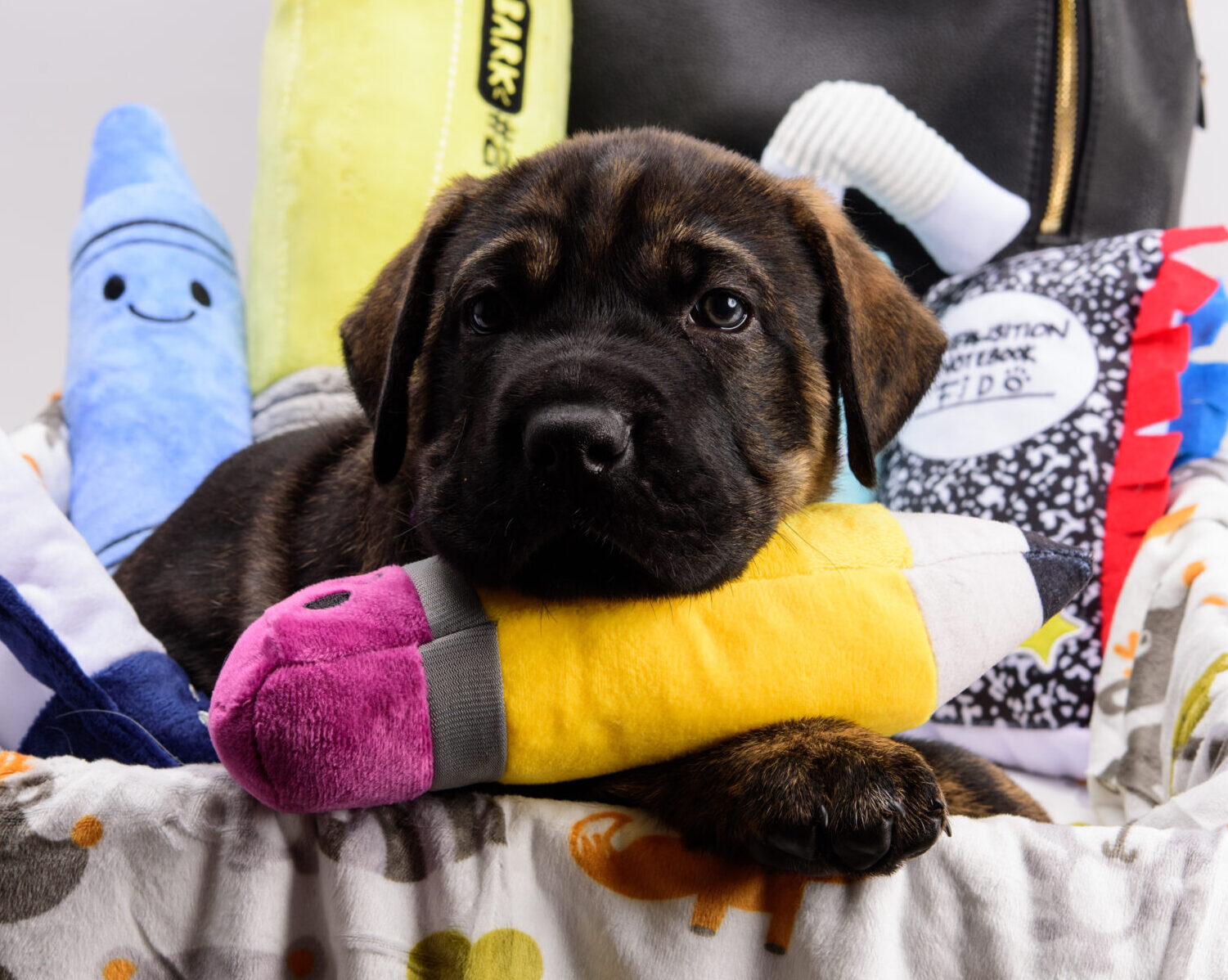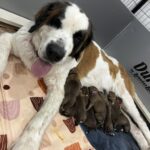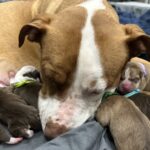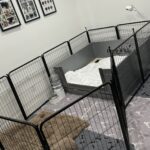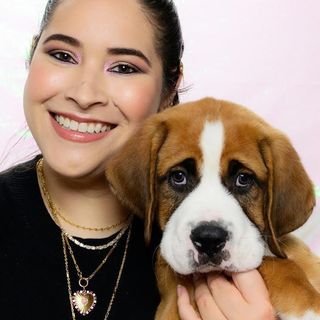The KinderPUP program follows the timeline of the Socialization Stage in the Five Stages of Growth a puppy goes through. The Socialization Stage begins around 3-weeks of age and continues through 12-weeks of age.
Even during the earliest part of this stage (3 to 6 weeks of age), puppies show improved confidence when presented with a new object and were quicker to recover from loud noises.1 However, the benefits of early socialization and habituation will be lost if we do not continue to work with the pup throughout this stage.1

Fosters should focus on familiarizing pups with common household objects, expected handling (e.g. how a veterinarian or a groomer might handle a dog), and a variety of people (even just putting a hat or sunglasses on can change the pup’s response!).3
Multiple studies have demonstrated that the puppy raising environment has a huge impact on the behavior of the puppy through adulthood.4
Passive enrichment of the pup’s area is an important part of habituating pups to novel objects over time. This is as simple as changing out toys every few days or introducing noise-making toys.5
How to Handle Puppies
Puppies are ready for increased holding, handling, and interaction with humans at the start of the Socialization Stage (three weeks old).
Puppies who experience frequent, positive encounters with humans are better able to bond with humans and react positively to strangers as adult dogs.6
Current studies and the consensus of dog behavior experts agree that appropriate socialization during this stage is paramount to puppies growing into adult dogs that are confident, social, and well-adjusted.7
Fosters should feel free to cuddle, snuggle, play, and pet their pups within this stage. If a puppy ever seems distressed, let it go to a safe place (like a hiding spot or their crate) or put it back in its pen.
Some puppies may be genetically predisposed to fear, so they may need more positive experiences and encouragement before they’ll allow more handling. Remember, it’s a marathon, not a race!
Don’t be afraid to gently pull at their ears and tail, inspect their growing teeth, and tickle paws. These are all areas that dogs can be sensitive to as adults but are areas that owners and vets need access to.

Introducing Passive Enrichment
The places the pups are kept, whether their sleeping area or a playpen, should be passively enriched.4
Passive enrichment includes having an assortment of textures, toys, and objects rotated in their pen(s) over time.4 This allows pups to explore and familiarize themselves with novel stimuli in a safe place, at their pace, and with the comfort of littermates.4

Below, we’ve put together a table of common items that can be added to playpens as a starting point. Refer to our weekly worksheets to ensure you’re adding age-appropriate enrichment (e.g. no slippery surfaces for pups just learning to walk!).
| Toys | Textures | Other |
|---|---|---|
| Ball | Bath mat | Cardboard box |
| Crinkly | Carpet patch | Music |
| Plastic/rubber | Cookie sheet | Ramp |
| Rattling | Cooling rack | Step stool |
| Rope | Muffin tin | TV |
| Squeaky | Non-slip mat | Wind chimes |
| Stuffed | Turf patch | Wobble board |
Obstacles
Another form of passive enrichment is by creating or adding obstacles. These are placed in the pen or in pups’ outdoor space to help them learn body awareness and build their muscles so they are more confident in their mobility. These can be introduced passively based on their age and mobility. Obstacles should be removed if pups start to destroy them.
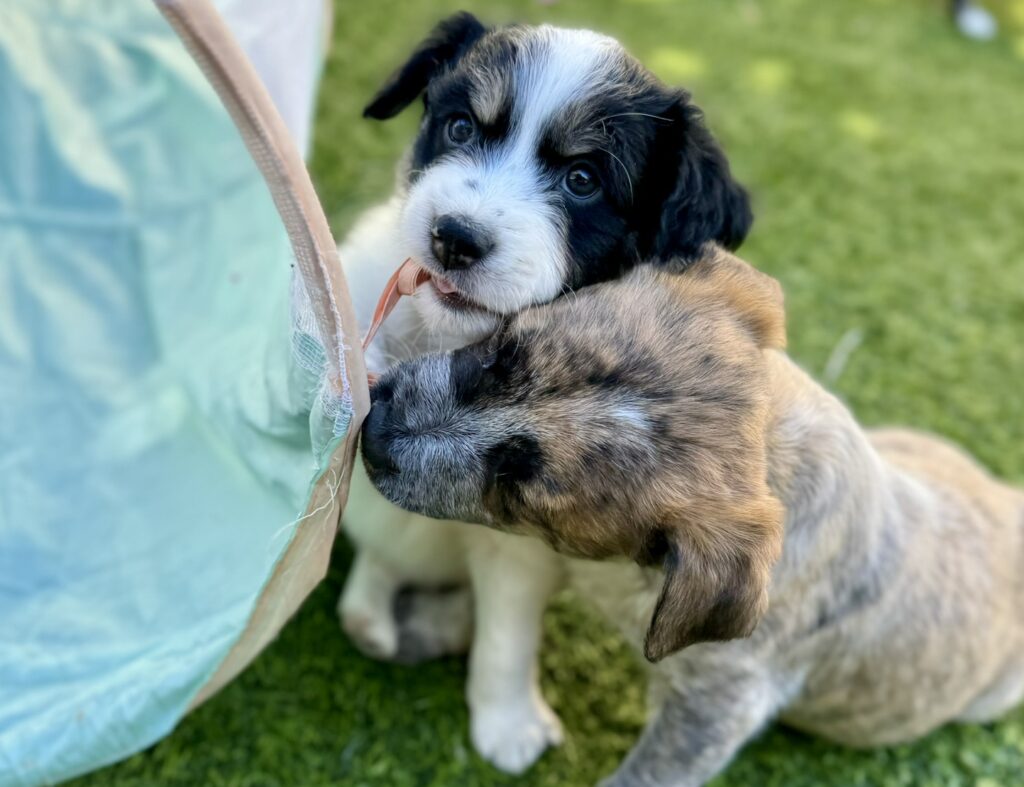
Not all obstacles need to be introduced in the same week–the weeks indicate the earliest we would suggest introducing that particular obstacle, but you’ll want to space out introductions throughout the Socialization Stage!
| Obstacle | Week 3 | Week 4 | Week 5+ |
|---|---|---|---|
| Balance board | Introduce | ||
| Bed | Introduce | Continue | Continue |
| Foam Roller | Introduce | Continue | Remove |
| Furniture Dolly | Introduce | ||
| Kiddie Pool | Introduce | ||
| Platform | Introduce | Continue | Continue |
| PVC Pipe | Introduce | Continue | |
| Ramp | Introduce | Continue | Continue |
| Slide | Introduce | Continue | |
| Stairs | Introduce | ||
| Step stool | Introduce | Continue | |
| Stepping stones | Introduce | Continue | Continue |
| Trampoline bed | Introduce | Continue | |
| Tunnel | Introduce | Continue |
Introducing People
Just about everyone loves a puppy, so if you ask, they will come. Puppies should meet a variety of people–as many as 30 over several weeks–from different genders, ages, ethnicities, and body types.4
If you are limited on individual people, you can also wear different types of clothing, like adding a hat, sunglasses, oversized jacket, etc.8
As always, the key is keeping these introductions and encounters as positive as possible. This means that you should keep introductions to one or two people, lower intensity (like just holding or petting) until the pup shows its ready for greater stimulus.

For example, pups between 3 and 4 weeks old should meet only one or two people at a time, and the duration should be based on their comfort level (likely shorter). As pups get older, they should be able to handle higher intensity encounters with people, including children who can easily mishandle a puppy, so ensuring a pup is comfortable being handled by adults before they interact with children is important.
These encounters should also be safe for the pups! People must sanitize their hands prior to interacting with your pups. They should remove their shoes or wear reusable/disposable booties to avoid exposure to things like Parvo.
How to Gauge Success
Just about everyone loves a puppy, so if you ask, they will come. Puppies should meet a variety of people–as many as 30 over several weeks–from different genders, ages, ethnicities, and body types.4
If you are limited on individual people, you can also wear different types of clothing, like adding a hat, sunglasses, oversized jacket, etc.7
As always, the key is keeping these introductions and encounters as positive as possible. This means that you should keep introductions to one or two people, lower intensity (like just holding or petting) until the pup shows its ready for greater stimulus.
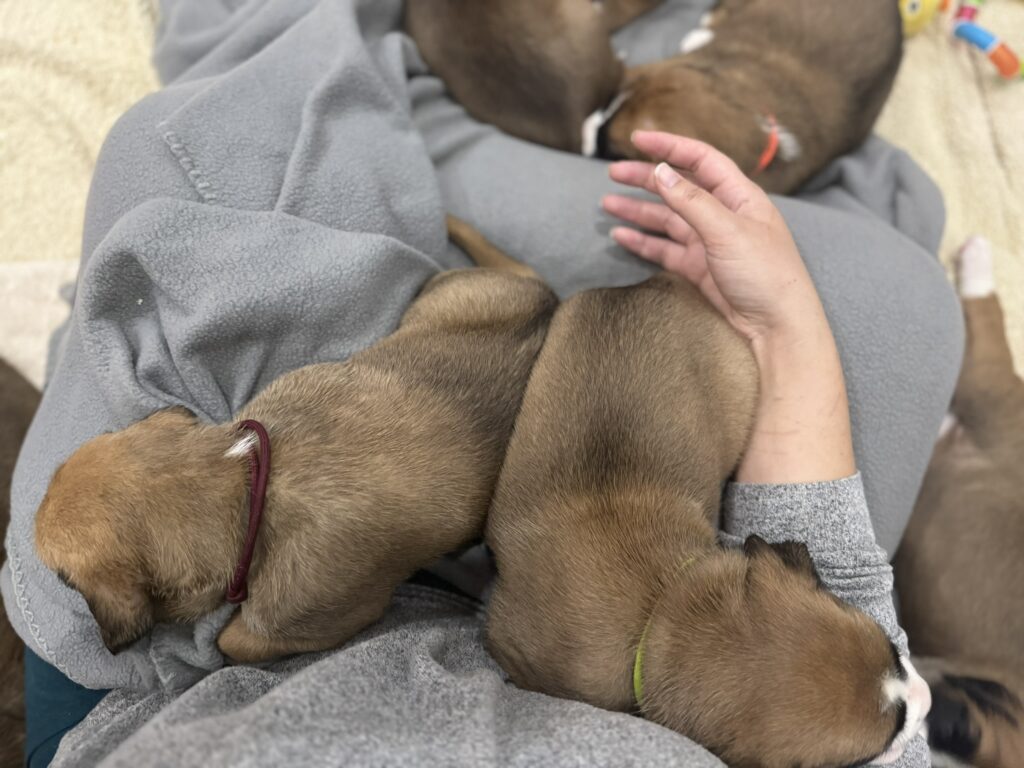
For example, pups between 3 and 4 weeks old should meet only one or two people at a time, and the duration should be based on their comfort level (likely shorter). As pups get older, they should be able to handle higher intensity encounters with people, including children who can easily mishandle a puppy, so ensuring a pup is comfortable being handled by adults before they interact with children is important.
These encounters should also be safe for the pups! People must sanitize their hands prior to interacting with your pups. They should remove their shoes or wear reusable/disposable booties to avoid exposure to things like Parvo.
Introducing Objects
Fosters can familiarize their pups with common household items, objects, and textures along with a variety of enrichment and toys.
As previously noted, introduction of objects can be done passively by putting novel stimuli into the pups’ space. We can also create more interactive experiences by moving those objects or introducing more complex items or ones that might cause harm if left with pups!2,4
We recommend giving your pups a “house tour” over the time they are in your care. This allows them to encounter the different sights, sounds, and things within different parts of a typical household.
For example, the kitchen is often the hub of a household, which may offer different flooring from other areas of the home, cabinets, trash can, appliances (which may be shiny or reflective).
Similarly, the bathroom can offer different textures for them to walk on (like the shower, tub, and bathmats). This helps them learn to walk on an assortment of textures and not develop phobias of them later on.
Next, we recommend rotating through toys. You don’t need to be regimented about it, but it’s good to offer a variety of toys throughout their foster period so that they get something new/different on a regular basis. Use toys that make different sounds and are made of different materials over time.
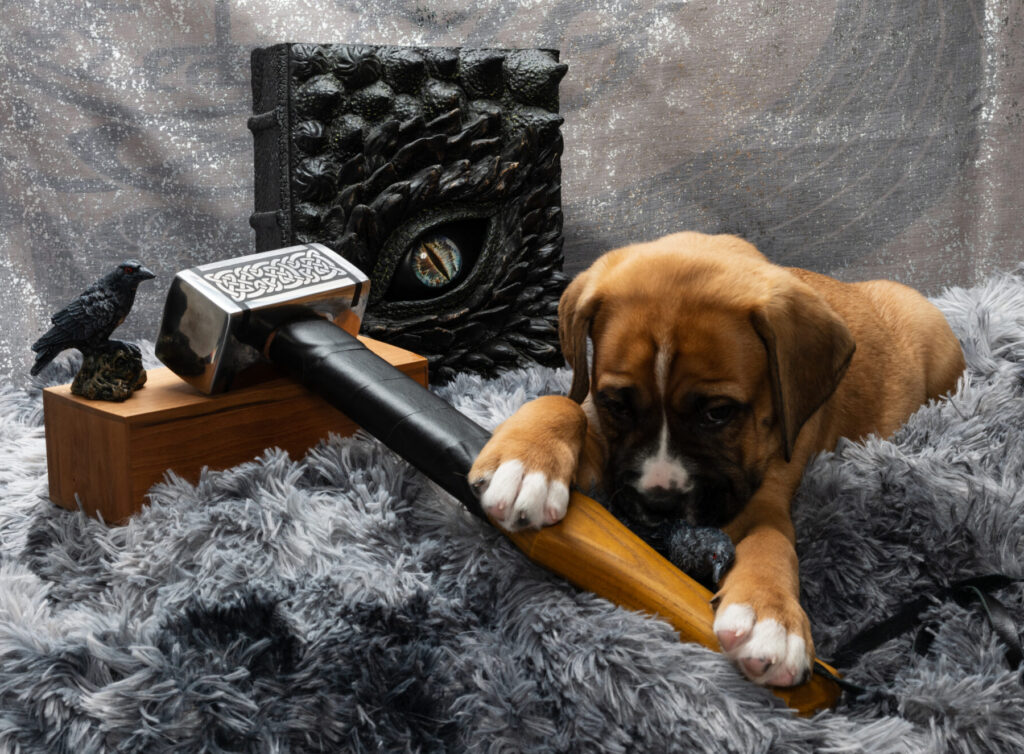
How to Gauge Success
Whether you’ve put in a new item into the pups’ pen for passive enrichment or you’re interacting with the pups and letting them explore a new item, there are clear markers that indicate the encounter is positive and going successfully.
| Successful | Unsuccessful |
|---|---|
| Approaches with curiosity | Disengages with foster |
| Engages with | Hides |
| Explores and moves on | Trembles |
| Mouths, sniffs, or touches | Whimpers or whines |
A successful interaction results in the puppy approaching and engaging with the object with curiosity or playfulness. If a puppy checks out the object and is then indifferent, that is still success.
It is important that puppies are given a chance to resolve inner conflict before lowering the intensity or removing the object. This looks like a pup who might yawn, whine, or be afraid to approach and with handler encouragement (touch and voice) or time (like one or two minutes), becomes more comfortable and then shows curiosity.7
If a pup remains stressed out and cannot resolve the inner conflict, try to engage the pup with a toy it enjoys and gentle handling to end the encounter on a more positive note.7
Introducing Sound
While puppies typically do not hear well enough to startle until around three weeks of age, their ear canals may start to open about a week earlier (around the same time as eyes open). Playing soothing music, like classical music, where puppies sleep may help to introduce them to sound and associate that sound to settling behaviors.7
Pups in a home environment are typically passively exposed to a variety of novel sounds throughout the foster period. If foster pups are being kept in a room away from typical household noises, we recommend setting up a playpen in a noisier area where pups can be exposed to household sounds for 15 to 30 minutes (more if they are doing well).
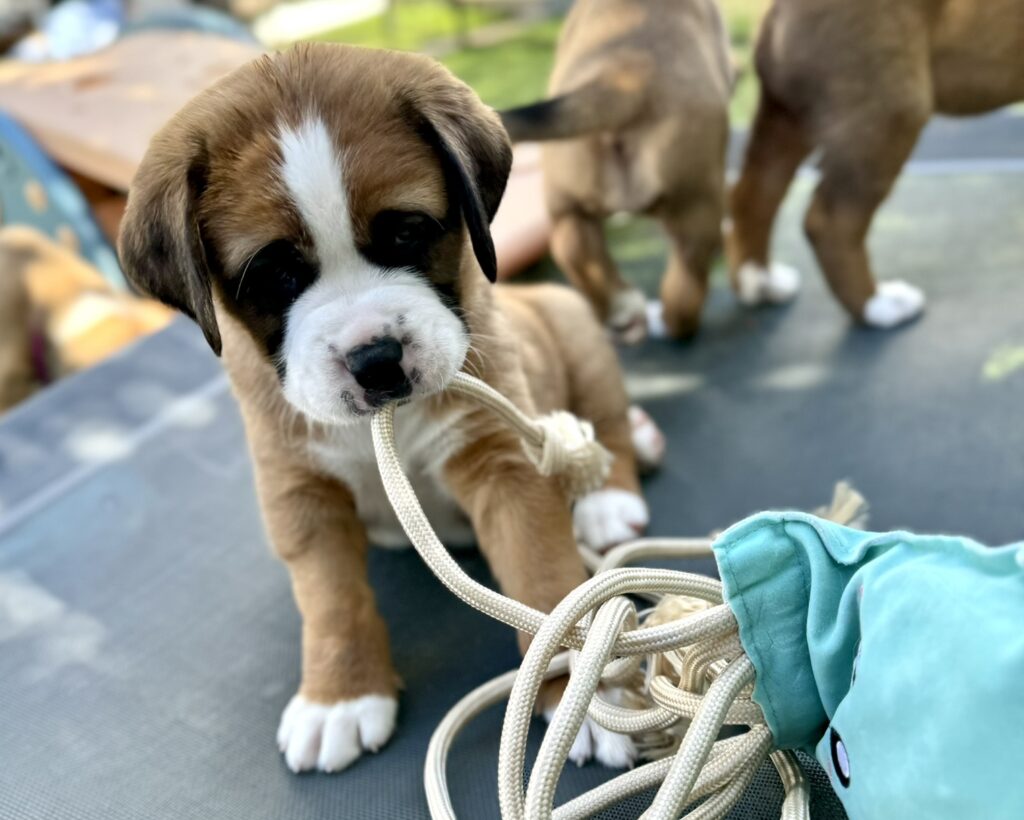
Startle Recovery
Between the ages of 3 and 6 weeks, puppies have a reflexive startle reaction where they have an immediate muscle contraction when exposed to sudden or intense sounds that is followed by immediate recovery.1
This is the response before puppies display a fear response. Puppies’ ability to be startled and then recovery quickly without feeling fear means that this is the ideal time to expose them to louder, more intense sounds.
It is important to continue exposing puppies to the sounds they have familiarized themselves with beyond the early Socialization Stage or else they will lose their confidence.1
Sound Ideas
Depending on your pups’ responses to more intense sounds, you can keep them closer or further away from the source of the sound.7 We’ve put together a list of ideas for sound introductions and the earliest we would recommend introducing them; the sounds should be introduced throughout the Socialization Stage, so don’t do them all at once!
| Sound | Week 3 | Week 4 | Week 5+ |
|---|---|---|---|
| Airplanes and helicopters | Introduce | Continue | |
| Clanging metal bowls | Introduce | Continue | Continue |
| Dishwasher | Introduce | Continue | Remove |
| Doorbell | Introduce | Continue | Continue |
| Dropping things | Introduce | Continue | Continue |
| Kids playing | Introduce | Continue | |
| Loading/unloading dishes | Introduce | Introduce | Continue |
| Opening/closing of doors | Introduce | Continue | Continue |
| Sirens | Introduce | Continue | |
| Trucks | Introduce | Continue | |
| Washer/Dryer | Introduce | Continue | Continue |
| Vacuum | Introduce | Continue | Continue |
| Video games | Introduce | Continue |
How to Gauge Success
With less intense sounds, pups may show slight curiosity and resume what they were doing, or they might not even notice the sound. With more intense sounds, you may find it startles the pup and then you’ll gauge its ability to recover (go back to what it was doing).
| Successful | Unsuccessful |
|---|---|
| Approaches source of sound | Doesn’t resume playing |
| Continues/resumes playing | Hides |
| Continues/resumes sleeping | Trembles |
| Tilts head | Whimpers or whines |
With louder sounds, like a vacuum, you may see the pup pause in reaction, but you want them to recover quickly, which means they go back to whatever it was they were doing. This reflexive startle reaction occurs between 3 and 6 weeks of age.1

It is important that puppies are given a chance to resolve inner conflict before lowering the intensity or turning off the sound. This looks like a pup who might yawn, whine, or be afraid to approach, and with handler encouragement (touch and voice) or time (like a minute), becomes more comfortable.7
If a pup remains stressed out and cannot resolve the inner conflict, try to engage the pup with a toy it enjoys and gentle handling to end the encounter on a more positive note.7
Lesson Plans
We promise working with your foster pup is easier than it may have sounded up until this point! Pups in foster homes tend to be exposed to many novel stimuli just because they’re in a household to begin with.
We have created lesson plans that work as your cheat sheets to helping to your pup be ready for its forever home! Each lesson plan is broken down into four areas:
Care: The daily/weekly tasks needed to provide basic care to your pup, such as replacing linens, grooming, feeding, and so forth.
Socialization: Recommendations for age-appropriate handling and socialization with new people or other animals.
Environmental Enrichment: Recommendations for age-appropriate passive enrichment within pups’ spaces.
Interactive Enrichment: Recommendations for age-appropriate enrichment while foster is actively engaged with pups.
Lesson Plans are comprehensive but fosters should always do as much as they’re able to do within the time they’re able to give to their fosters. Bonus tasks are indicated with a star symbol for tasks that take extra time for extra credit, so-to-speak!
Fosters caring for multiple puppies, particularly an entire litter, will need to do what is reasonable based on number of puppies in their care.
KinderPUP Program Guides
- What is KinderPUP?
- Week 3 Lesson Plan
- Week 4 Lesson Plan
- Week 5 Lesson Plan
- Weeks 6-7 Lesson Plan
- Weeks 8-9 Lesson Plan
- Weeks 10-12 Lesson Plan
Footnotes
- Stolzlechner, Lisa et al. “Optimising Puppy Socialisation-Short- and Long-Term Effects of a Training Programme during the Early Socialisation Period.” Animals : an open access journal from MDPI vol. 12,22 3067. 8 Nov. 2022, doi:10.3390/ani12223067. ↩︎
- Dietz L., Arnold A.-M.K., Goerlich-Jansson V.C., Vinke C.M. The importance of early life experiences for the development of behavioural disorders in domestic dogs. Behaviour. 2018;155:83–114. doi: 10.1163/1568539X-00003486. ↩︎
- McEvoy, Victoria et al. “Canine Socialisation: A Narrative Systematic Review.” Animals : an open access journal from MDPI vol. 12,21 2895. 22 Oct. 2022, doi:10.3390/ani12212895. ↩︎
- Supplementary guidance for dog breeders on the socialisation … (n.d.). https://food.ec.europa.eu/system/files/2022-07/aw_platform_plat-conc_guide_socialisation_puppy.pdf ↩︎
- Elliott O, Scott JP. The development of emotional distress reactions to separation, in puppies. J Genet Psychol. 1961;99:3–22. ↩︎
- Howell, Tiffani J et al. “Puppy parties and beyond: the role of early age socialization practices on adult dog behavior.” Veterinary medicine (Auckland, N.Z.) vol. 6 143-153. 29 Apr. 2015, doi:10.2147/VMRR.S62081. ↩︎
- “Early Socialization Project.” International Working Dog Registry, http://www.iwdr.org/early-socialization-home/. ↩︎

